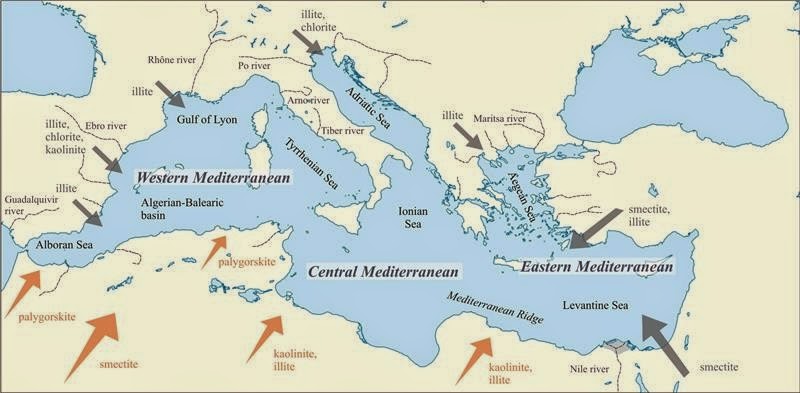Geologists once thought that the Mediterranean was a tiny remnant of the Tethys Sea, the great ocean that once separated the world’s northern and southern continents. In fact, the Black Sea is the only remnant of the Tethys in Europe. The Mediterranean has a far briefer but more complex history. Essentially, the Mediterranean is a deep basin between the converging tectonic plates of Europe, Anatolia, and Africa, and the eastern, central, and western Mediterranean have different geological histories, which is why today, the east is earthquake prone, the centre is dotted with active volcanoes, and the west is relatively quiet.
2 mediterranean [Latin mediterraneus, from medius middle + terra land — more at terrace entry 1] : enclosed or nearly enclosed with land It is a sea nearly as mediterranean as that which lies between Africa and Europe.. Phoenicians. The Phoenicians are identified as a loosely connected network of traders throughout the Mediterranean. Phoenician civilization flourished between 1550 and 300 BCE.
The Biggest Mediterranean Islands
Sicily. Without a doubt, Sicily is the largest island located in the Mediterranean Sea. …
Sardinia. Another Italian island makes the list at number 2. …
Cyprus. …
Corsica. …
Crete.
Coon wrote that marked Mediterranean features included skin color ranging “from pink or peaches-and-cream to a light brown”, a relatively prominent and aquiline nose, considerable body hair, and dark brown to black hair.
Calypso Deep, located in the Hellenic Trench, Ionian Sea 62.6 km south-west of Pylos, Greece, is the deepest part of the Mediterranean Sea, with a maximum depth of 5,267 m (17,280 ft), at 36°34′N 21°8′E .
This biome contains evergreen broad-leaved and aciform trees, including: holm oaks, arbutuses, olive trees, laurels, carob trees, pine trees, junipers, cypresses and others. It also includes shrubby plants, for instance rock roses, mastic trees, myrtle and rosemary.
From ancient times the Mediterranean Sea served as a great highway, linking the lands around its shores. It played an important role in the Roman Empire, in the rise of Italy’s maritime* cities, and in the expansion of the Islamic world across northern Africa to Spain.
Filling the Med
The modern Mediterranean, though, dates from 5.3 million years ago. About 5.6 million years ago, the Mediterranean basin was completely cut off from the Atlantic, and a warm, dry climate slowly evaporated most of the water leaving just a few very salty dregs in the lower parts of the basin, in what is called the Messinian Salinity Crisis. Then, 5.3 million years ago, the strip of land separating the Atlantic and the Mediterranean basin was suddenly breached through a 200 km (124 mile) wide channel across the Strait of Gibraltar. In a cataclysmic flood, called the Zanclean flood, water gushed through the breach at a rate that would totally dwarf the Amazon, with a velocity of some 300 km (186 miles) an hour. It filled the basin like a bath, adding 10 m (33 ft) to the water level every day and filling the entire Mediterranean in less than two years.
Because 90 percent of the Mediterranean’s water came in from the Atlantic in this way, most of the marine life in the Mediterranean today was originally from the North Atlantic. It has adapted to the warmer, saltier environment of the Mediterranean in the five million years since, but the balance of species reflects their cool Atlantic heritage. The Alboran Sea between Gibraltar and Africa is a transition zone with a mix of Atlantic and Mediterranean species. It is also home to the Mediterranean’s last population of harbour porpoises and is a key feeding ground for loggerhead turtles.
Double loops
Today, there is a constant influx of surface water from the Atlantic through the Strait of Gibraltar to make up for all the water that evaporates from the warm surface of the Mediterranean. This inflow sets a counterclockwise circulation of fresher surface water through the western Mediterranean, streaming along the north coast of Africa, then looping back past Sardinia, France, and Spain. The Atlantic flow also streams on farther through the Strait of Sicily to set in motion a similar counterclockwise circulation in the eastern Mediterranean. As it goes farther east, though, evaporation from the surface makes it increasingly salty and cooler, until eventually it starts to sink and flows back out west into the Atlantic underneath the incoming flow, 150 years or so after it arrived.
Mediterranean life
The Atlantic water that keeps the Mediterranean topped up is highly oxygenated, which keeps the Mediterranean well aerated, but it is poor in nutrients. So the Mediterranean’s phytoplankton blooms are concentrated in the Adriatic Sea, where there are local upwellings, and close to coasts and estuaries where rivers wash in nutrients. It is this limited plankton growth that keeps the Mediterranean so vividly blue in the summer. In summer, the calm, warm weather allows the surface waters to heat up with a minimum of mixing with lower layers, reducing the availability of nutrients in the surface layers. In autumn and winter, however, stormier weather stirs up water from the lower depths and helps stimulate plankton blooms in the autumn, and so provides feeding opportunities for larger organisms, from shrimp to seals.
If the limited plankton growth means the Mediterranean’s marine life is not that large in mass, it more than makes up for it in sheer diversity, with 10,000–12,000 species recorded, which is unusual for a temperate sea. There are 19 species of cetaceans in the Mediterranean alone, including fin whales, sperm whales, pilot whales, striped dolphins, Risso’s dolphins, bottlenose dolphins, and common dolphins. There are also endangered monk seals, green and loggerhead turtles, devil rays, and Maltese skates, mako, sandbar, porbeagle, and angel sharks and more than 900 other species of fish, including blue-fin tuna and swordfish. One particularly important plant species is the seagrass Posidonia oceanica, which grows on shallow coastal seabeds. The seagrasses act as nurseries for many of the Mediterranean’s key species, but like seagrasses in many places, they are in decline.


